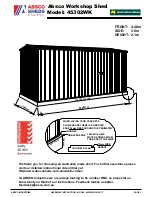
Component List
• Tent Body
• Tent Fly sheet
• Shock corded poles (2)
• Tent bag with separate pole bag
• Stake bag
• Stakes (8)
Instructions
1. Inspect the chosen site and clear all sharp
and/or protruding objects that can damage the
tent floor. (We recommend the use of a Eu-
reka Floorsaver positioned under the tent for
added floor protection) Be sure the site will
offer proper drainage of rainwater away from
the tent.
2. Spread out the tent body in the chosen loca-
tion. If in windy conditions the windward tent
corner can be staked down. Assemble the
shock corded frame poles. Be sure that pole
ferrule connections are fully inserted.
3. Insert one of the poles through the rod
sleeves located on the top of the tent body.
The pole will travel through the sleeves diago-
nally from one corner to the other. Always
push poles through sleeves. (Pulling through
sleeves may separate pole sections at fer-
rules resulting in potential breakage when
stressed).
4. Repeat step 3 with the second shock corded
pole. The two poles will now be inserted
through the pole sleeves and forming an X
pattern on the tent.
5. Starting in one corner, windward corner if
windy, insert the pole end tip into the corner
tent grommet. Move to the other end of the
pole, flex the pole and insert the pole tip into
the corner tent grommet. (Note; if there is re-
sistance when flexing the pole check for fabric
snags and loosen. If a second person is avail-
able they can support the flexing pole and
freeing any fabric snags.)
6. Repeat step 5 with the second pole. The inner
tent body should now be upright. Attach tent
clips to the frame.
7. The inner tent can now be staked down in the
desired location by staking at all 4 corners.
Stakes should be angled into the ground with
the stake head leaning away from the tent.
8. Set the fly sheet over the tent positioning the
vestibule doors in line with the tent doors.
Wrap the hook and loop straps, located on the
underside of the fly sheet, around the frame
poles. Connect the side release buckles, lo-
cated on the fly sheet corners, to the buckles
on the tent corners. Adjust the web straps to
make a tight and smooth fit of the fly on the
tent.
9. Stake out both vestibules
10. Side loops, on the sides of the fly sheet, are
recommended to be staked out especially in
rainy conditions.
10. Four lash points, one on each shoulder of the
tent, can be secured using a guy line and
stake in windy conditions providing increased
wind stability
Tips
• The suns UV rays can be harmful even with
technical advances in fabrics. Prolonged ex-
posure could result in fading and possibly fab-
ric disintegration. When choosing a site try to
pitch the tent in a shaded area. Do not leave a
tent up longer than necessary.
• Fuels can damage tents as can DEET found
in many insect repellents.
• All major seams are factory taped. Over time
seams could delaminate. Simply clean the
seam and apply seam sealer that can be pur-
chased at most outdoor stores.
• Avoid storing your tent in a hot location.
• Please be sure to store your tent dry. Mildew
can occur on waterproof coatings if stored
when wet.
• We recommend the use of a thin groundsheet
or Floorsaver with any tent for added protec-
tion from abrasion. The Floorsaver should be
about 10cm. (4 inches) from the tent edge to
avoid the possibility of channeling water be-
neath the tent.
Mountain Pass 2/3/4XT-C
TENT INSTRUCTIONS
eurekatentscanada.com
4180 Harvester Rd., Burlington, Ont L7L 6B6
905 634 0023




















